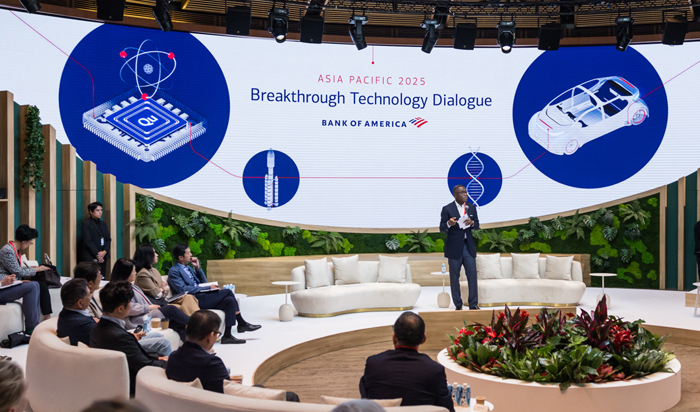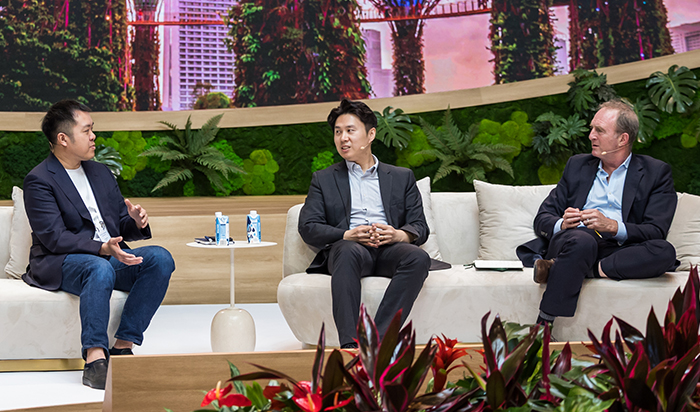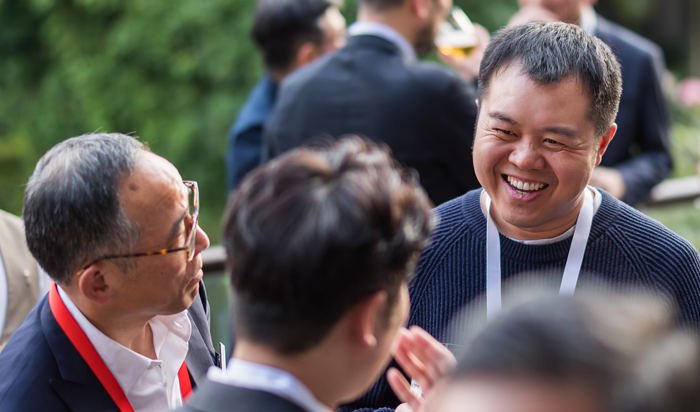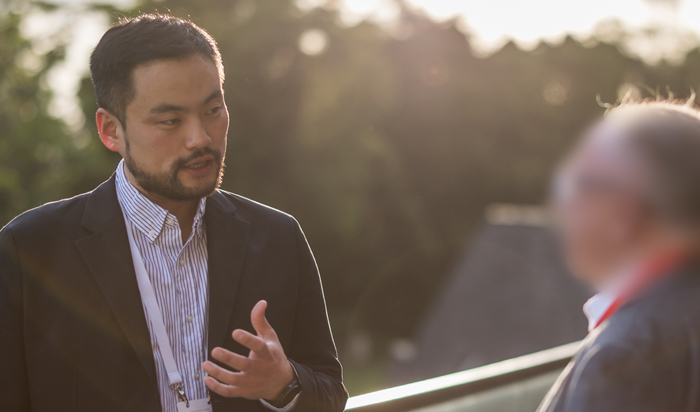Yao believes that AGI will be achieved in less than 10 years. “This is a pretty common assumption among industry leaders because we’re seeing a faster and faster evolution of AI’s capabilities,” he says.
AI gets physical
The shape artificial general intelligence will take is becoming clearer
Key takeaways
- Experts believe artificial general intelligence (AGI) could become a reality within the next decade.
- Industry participants believe it will manifest itself in two ways: in the cloud where a digital agent or twin will manage multiple other agents on individual devices and in the physical world, where embodied AI (robots) will become increasingly commonplace working alongside and assisting humans.
- Asians are the most optimistic globally about AGI’s potential benefits but remain concerned by a more limited number of AI models reflecting the region’s languages and culture.
What will it mean for businesses and the individuals who either own them or work for them if machines can equal or overtake a human’s cognitive abilities? The timing and implications of reaching this state, known as artificial general intelligence (AGI), are being ever more vigorously debated as the prospect moves closer and closer.

Bernie Mensah, President of International, Bank of America welcomes attendees
One delegate, speaking at Bank of America’s inaugural Asia Pacific Breakthrough Technology Dialogue in Singapore told the assembled industry leaders, investors and academics that the DeepSeek moment for robotics would be coming very soon, possibly by the end of 2025.
Technology moves quickly. But true breakthroughs tend to be defined by the moment when they enter mass consciousness.
In January 2025, for example, the launch of DeepSeek’s R1 model created headlines across the world, with media commentators highlighting how the Chinese company appeared to have achieved the same performance as leading AI models at a fraction of the cost1,2.
For robotics or physical AI, a similar awakening may occur when humans start to see a much closer reflection of themselves in machines: flexible and intuitive rather than mechanical and repetitive.
The advent of these humanoids, as they are being termed, is being driven by the technical integration of foundational AI models (soſtware) into robots (hardware). This is enabling robots to use cognitive reasoning to interact with and learn from the environment around them for the first time.
The current wave of investments into robotics has a new name – embodied AI. As Dr. Maoqing Yao, executive VP of R&D and Embodied Intelligence, at Shanghai-headquartered robotics company AgiBot, explains:
Drones, humanoids and self-driving cars are all now entering our physical lives and will become increasingly prevalent. They will change the way we think of transport, manufacturing and even housekeeping.
Agentic AI multiplies
One trend helping to accelerate this is a shiſt in computer processing power away from centralised cloud servers to individual devices and machines (edge AI). Tony Fadell, principal, Build Collective, predicts that most computer processing power will move to the edge over the next four years, boosting the ability of devices to act on their owner’s behalf (agentic AI).
He states:
We’ll all have a digital twin, or an agent in the cloud that will be co-ordinating with all the agents on our devices, whether that be a car, phone, watch or computer.
And he adds; “We’re not quite there yet. But in the next two to three years, we’re going to see our current hardware start to act in interesting ways that won’t require us to be tapping on screens anymore.”
Dr. David Ha, CEO and founder of Tokyo-headquartered Sakana AI, adds that devices will become ever more personalised. He believes AI agents will need to be customised at a coding as well as a data level.
Embodied AI: moving from structured to semi-structured environments
The first iterations of embodied AI have already been around for a number of years. Automation in manufacturing is widespread: industrial robots completing specific tasks without sensors checking if they have achieved the desired outcome (open-loop controls).
AgiBot’s Yao says the next generation will move out of factories and warehouses into less rigidly structured environments such as grocery stores. Here they will be stacking shelves, fulfilling orders, or operating bar scanners. Semantic mapping, or the technology of allowing robots to complete tasks without bumping into things, involves augmenting spatial maps with semantic labels of describing what is where in real time rather than just its visual appearance.
Further down the line, Yao foresees robots being able to handle open-ended questions and adapt to changing environments such as within people’s home. At this point, they will be capable of the kind of non-linear thinking that only humans and animals currently possess.

Dr. David Ha, Sakana AI, Dr. Maoqing Yao, AgiBot, and James Harding, The Observer, discuss the intersection of AI, robotics and humans
BofA Global Research analysts also believe in a three-stage development trajectory, forecasting total ownership to jump from 18,000 units in 2025 to three billion by 2060. This corresponds to approximately 0.3 robots per capita, slightly higher than current use of passenger vehicles but lower than smartphones.
Such humanoids convey images of bipedal machines. Yet in many instances, robots do not and will continue not to look like humans at all, having been designed for tasks that humans cannot or do not want to do because they are, for example, either repetitive or dangerous.
Patrick Zhong, founding Managing Partner of Shanghai-based private equity firm M31 Capital, advocates this as one reason not to fear them.
He says:
Robots can do things that humans never imagined they could such as complex medical operations in very small cavities within the human body.

Patrick Zhong, M31 Capital, listens intently

Dr. David Ha, Sakana AI, draws a crowd
Sakana AI’s Ha acknowledges that robots will cause massive disruption to the world of work. But he argues that the results will be positive.
Ha states:
Humans will adapt to this just as they did when cars replaced horses and carriages. Lots of new jobs will be created for people who work with AI. Humans and AI will work together.
Zhong agrees saying that AI will not only enhance productivity at work, but potentially human happiness as well.
Far from being displaced by AI, some workers may, therefore, find themselves managing groups of AI employees instead. And autonomous mobility may also free up time for other pursuits – perhaps commuting to the office while exercising on a stationary bike at the back of a vehicle driven by a machine.
This is a future that Dr. Brian Gu, vice chair and president of Chinese electric vehicle (EV) company XPENG, envisages.
He comments:
It’s going to be a huge transformation. People will be able to do many things other than driving. And in China, I think half of all cars will have a high degree of autonomy within the next three to four years.

Dr. Brian Gu, XPENG, in conversation
Re-thinking what it means to be human
Dr. Jinwook Oh, co-founder and CTO of South Korean-based Rebellions Inc, says that AGI will prompt deep reflection about what it means to be human.
He remarks:
AI will change how we think about computers and how we think about ourselves. It will provide us with a new prism to view the world. We’re at a moment in time when a new way of life for humans is being defined.

Dr. Jinwook Oh, Rebellions Inc., shares his view
One striking aspect about this debate is a geographical divide between how Asia and other parts of the world view it. Studies show that Asians rank as the most optimistic globally about AI.
The 2024 Ipsos AI Monitor, for example, found that respondents from China lead the world in being excited about products and services using AI (80%), with South Korea not far behind on 73%3. At the other end of the report’s scale, however, are English-speaking countries led by Ireland, followed by New Zealand, the UK, US, Australia and Canada in feeling nervous about it (all over 60%).
Bing Song, Senior Vice President of the Berggruen Institute and Director of its China Center in Beijing, studies why history and culture have made East Asians more positive. “Major Eastern philosophies like Confucianism, Daoism, Shintoism or Buddhism, emphasise the primordial connectivity and oneness of all sentient beings,” she says. In classical Chinese thinking, the construct for understanding humans is through a trinity of heaven-earth-humanity, or Tian-Di-Ren (天地人三才).
She adds:
AI isn’t feared in the Eastern tradition because so many people believe that humans have always lived alongside more powerful beings. It’s embedded in the psyche. In the Western and modern thinking, human subjectivity and primacy is far more front-and-centre, especially since the Industrial Revolution.

Dr. Ong Chen Hui, IMDA, Biztech Group and Bing Song, Berggruen Institute drawing cultural comparisons
Indeed, in 2024, the Chinese film “Ne Zha 2” became the world’s highest-grossing animated movie of all time4. It tells the story of a young figure striving to reconcile their dual nature as part human, part deity.
A WEIRD phenomenon
However, while Asians may welcome AI, many existing Large Language Models (LLMs) do not reflect the region’s multiple different cultures. The concept WEIRD (Western, Educated, Industrialised, Rich, Democratic) is a widespread acronym defining the phenomenon of basing research on datasets that are not representative of the global population5.
Over the past few years, the growth in local language LLMs has partially rectified this. One example is Singapore’s SEA-LION LLM (South East Asian Languages in One Network). The initiative, launched in December 2023, trains on content produced in South East Asian languages including Thai, Vietnamese and Bahasa6.
Dr. Ong Chen Hui, assistant CEO at the Infocomm & Media Development Authority’s (IMDA) Biztech Group, is a lead on the Singapore government project. She reiterates the importance of data inputs based on local languages and culture. “In Singapore, we’re multiracial and multicultural but we found that existing AI systems don’t quite reflect the values we hold dear,” she says. In overcoming this, one issue smaller countries have been grappling with is more limited data sets to train models on.
As Ong notes:
We’ve had to think very carefully about what capabilities we need in addition to how we create models that reflect our national identity.

Dr. Ong Chen Hui, IMDA, Biztech Group and Chris Wright, Resonate Global Advisors talk the talk on LLMs
Is the Singularity near?
In his 2005 book, The Singularity is Near, the futurologist Ray Kurzweil predicted that human and machine intelligence would merge around the year 20457. In 2024, he doubled down on this prediction with his follow up book, The Singularity is Nearer8.
In the past few years, a prospect once contained within the realms of science fiction, has started to edge towards reality following the launch of companies actively exploring brain-computer interfaces (BCI). In 2024, the World Economic Forum predicted the sector would grow from US$1.74 billion in 2022 to US$6.2 billion by 20309.
The potential for the medical field is clear, especially in support of people with paralysis. Less certain is whether or how BCIs will be able to augment the processing power of human brains. Whether this will be needed at a time when AI is propelling the processing power of computing ones at an exponential rate also remains an open question10.
1 DeepSeek-R1 Release. (2025, January 20). DeepSeek.
2 Heikkilä, Melissa (2025, January 29). DeepSeek’s ‘aha moment’ creates new way to build powerful AI with less money. Financial Times.
3 Ipsos. (2024, June). The Ipsos AI Monitor 2024.
4 The Conversation. (2025, February 18). Ne Zha 2: the ancient philosophies behind China’s record-breaking new animated film.
5 Henrich, Joseph., Heine, Steven, J., Norenzayan, Ara. (2010, June 15). The weirdest people in the world? Cambridge University Press.
6 IMDA. (2023, December 4). Singapore pioneers S$70m flagship AI initiative to develop Southeast Asia’s first large language model ecosystem catering to the region’s diverse culture and languages. IMDA.
7 Kurzweil, Ray. (2005, September). The Singularity is Near: When humans transcend biology. Viking Books, Chapter 3.
8 Kurzweil, Ray. (2024, June). The Singularity is Nearer: When we merge with AI. Penguin Books.
9 Alohaly, Manar. (2024, June 14). The brain computer interface market is growing – but what are the risks? World Economic Forum.
10 Slattery, Peter., Roded, Tal, Del Sozzo, Emanuel., & Lyu, Haoran. (2025, January 3). What drives progress in AI? Trends in compute. MIT FutureTech.




